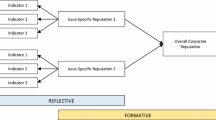Abstract
The management of reputation inevitably requires measurement. However, the object, methodology, underlying research interest and further use of measurement findings may vary. This part provides an insight into the various aspects of measurement and its relevance for reputation management. It closes with a meta-study examining the financial impacts of reputation as measured by several researchers.
Access provided by Autonomous University of Puebla. Download chapter PDF
Similar content being viewed by others
Keywords
These keywords were added by machine and not by the authors. This process is experimental and the keywords may be updated as the learning algorithm improves.
The management of reputation inevitably requires measurement. However, the object, methodology, underlying research interest and further use of measurement findings may vary. This part provides an insight into the various aspects of measurement and its relevance for reputation management. It closes with a meta-study examining the financial impacts of reputation as measured by several researchers.
Liehr-Gobbers and Storck open with an introduction on how reputation can be measured in general. The paper stresses out the range of methods existing for both media evaluation and stakeholder research. The authors systematically list which cognitions the various methods are able to provide. The closing presentation of the “Barcelona Declaration of Measurement Principles” introduces the reader to the state-of-the-art of PR measurement.
In the second chapter, Helm and Klode describe the “Challenges in Measuring Corporate Reputation” most communication professionals should be aware of when selecting a measurement tool. The authors expand on the pros and cons of single- versus multi-item measurement concepts, discuss formative versus reflective models and evaluate the benefits of low and higher order factors. In a second part, Helm and Klode introduce common measurement tools used both by practitioners and in academia and discuss the need for non-standardized tools.
“Measuring Media Corporate Reputations” is the primal yet most common measurement communication practitioners and researchers have focused on. Dowling and Weeks recapitulate the reasons for analyzing media coverage, give hands-on suggestions for an effective presentation of the media analysis and explain which action steps should be derived from its findings.
Another type of measurement is applied by Fiedler for his study on “Reputation Management in Different Stakeholder Groups.” Fiedler uses an innovative approach to scrutinize the components of corporate reputation and its effects on stakeholder commitment and to analyze the differences that occur between various stakeholder groups: he combines stakeholder theory with social network theory and thus takes into account the power of word-of-mouth communication. Based on his findings, “tailored reputation management strategies” can be derived.
Unlike Fiedler, Walsh, Beatty and Holloway focus on just one stakeholder group: customers. Regarded from a marketing point of view, the measurement of corporate reputation can be used as a new tool to segment various customer groups. Combined with traditional segmentation techniques, important insights for a differentiated marketing planning can be gained.
Apart from stakeholder research, examinations on the financial impact of corporate reputation are a major field of interest within the communication community. De Quevedo Puente, Delgado García and de la Fuente Sabaté close this chapter with a meta-analysis of studies on this issue. They systematically describe previous findings concerning the impact on corporate profitability, risk and market value. Additional explanations for inconsistent measurement results are provided, too.
Author information
Authors and Affiliations
Corresponding author
Editor information
Editors and Affiliations
Rights and permissions
Copyright information
© 2011 Springer-Verlag Berlin Heidelberg
About this chapter
Cite this chapter
Helm, S., Liehr-Gobbers, K., Storck, C. (2011). Overview. In: Helm, S., Liehr-Gobbers, K., Storck, C. (eds) Reputation Management. Management for Professionals. Springer, Berlin, Heidelberg. https://doi.org/10.1007/978-3-642-19266-1_9
Download citation
DOI: https://doi.org/10.1007/978-3-642-19266-1_9
Published:
Publisher Name: Springer, Berlin, Heidelberg
Print ISBN: 978-3-642-19265-4
Online ISBN: 978-3-642-19266-1
eBook Packages: Business and EconomicsBusiness and Management (R0)




